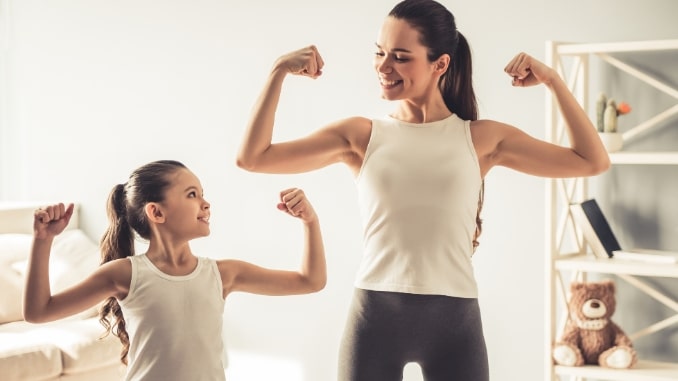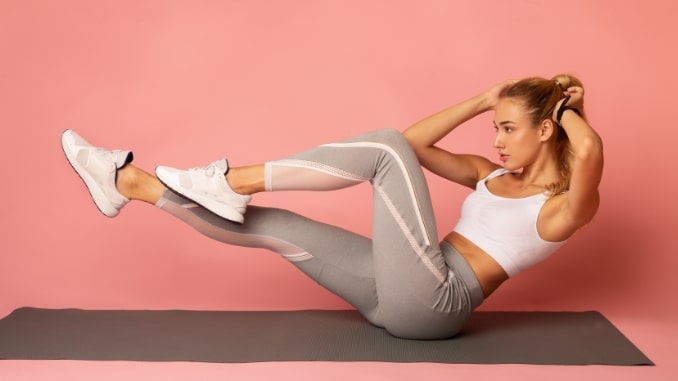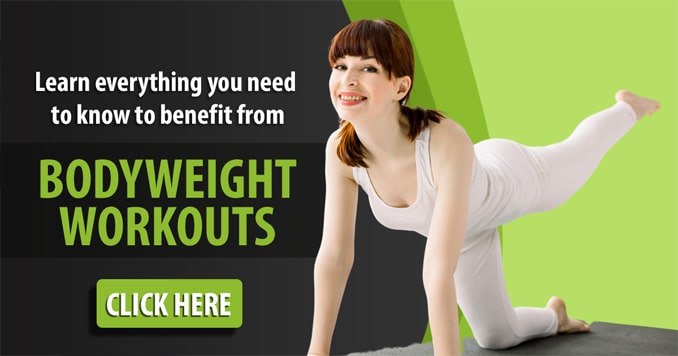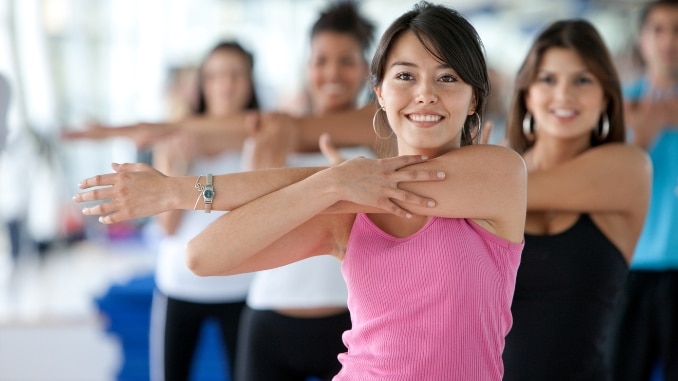
Embarking on a fitness journey doesn’t always require an arsenal of gym equipment. There are numerous no equipment full body workout that you can try. Simplicity can be the key to success. In a world teeming with fitness trends and expensive gear, this article is your gateway to a healthier you without needing costly gym equipment. We’ll uncover the art of sculpting and strengthening your body using your body weight and creative exercises. Discover the freedom of exercising wherever you choose, and join us in exploring the limitless potential of a no equipment fitness regimen.
Importance of Staying Fit and Exercising Regularly
Staying fit and regularly working out benefits your physical and mental well-being, reducing the risk of chronic diseases, enhancing your cardiovascular health, strengthening your immune system, and uplifting your mood.
Participating in consistent physical activity not only aids in maintaining a healthy weight but also enhances sleep quality. With the busy and sedentary lifestyles many of us lead, finding time for exercise can be challenging. That’s where no equipment full body workouts come in handy. They provide a convenient and effective means of staying in shape without costly gym memberships or equipment.
Can you do a Full Body Workout Without Equipment?
Absolutely! Contrary to common belief, you don’t need fancy machines or weights to achieve a full-body workout. Your body weight can provide enough resistance to challenge and strengthen your muscles. No equipment full-body workouts utilize a combination of compact bodyweight exercises that target multiple muscle groups simultaneously. This means you can work your upper and lower body, as well as your core, all in one workout. By varying the intensity and complexity of the exercises, you can customize your home workout to suit your fitness level and goals.
What is a No Equipment Bodyweight Exercise?
A no-equipment full-body workout is a fitness routine that targets all major muscle groups without needing equipment or weights. It focuses on using your body weight as resistance to build strength, increase endurance, improve flexibility, and often incorporates high-intensity interval training (HIIT). These workouts involve a combination of cardio, strength training, and functional movements to create a well-rounded exercise routine. HIIT adds an extra layer of intensity, helping you burn calories efficiently and boost your metabolism. These exercises can be performed variously, making them ideal for your at-home workout routines, outdoor training, or when you’re traveling and don’t have access to a gym.
What are the Benefits of Full Body Workouts with just your Body Weight?
No equipment full body workouts offer numerous advantages that make them an excellent choice for fitness enthusiasts of all levels:
- They are cost-effective and accessible to everyone. You don’t need expensive equipment or gym memberships to get a great workout.
- They save time. Since these workouts engage multiple muscle groups simultaneously, you can achieve a full-body workout faster than isolating individual muscle groups with weight machines or dumbbells.
- No equipment full body workouts improve functional fitness by mimicking real-life movements, making you stronger and more capable in your daily activities.
Key Exercises for a No equipment Full Body Workout
When it comes to no-equipment full bodyweight training workouts, there is a wide range of exercises to choose from. Here are some essential bodyweight exercises that target different muscle groups and provide a well-rounded workout:
1. Push-Ups
Push-ups are a timeless exercise focusing on the chest, shoulders, triceps, and core. They can be adapted to accommodate various fitness levels by altering hand placement or doing knee push-ups.
2. Squats
Squats are excellent for working the lower body, including the quadriceps, hamstrings, and glutes. They also engage the core and improve balance.
3. Lunges
Lunges primarily target the quadriceps, hamstrings, and glutes. They also engage the core and improve stability. Variations like walking lunges or reverse lunges can add variety to your workout.
4. Plank
Planks effectively strengthen the core muscles, including the abdominals, obliques, and lower back. They also engage the shoulders and glutes.
5. Burpees
Burpees are a full-body exercise that incorporates cardio and strength training. They work the arms, chest, shoulders, abs, glutes, and legs. This high-intensity exercise helps burn calories and increases endurance.
6. Mountain Climbers
Mountain climbers are dynamic bodyweight exercises that target the core, shoulders, chest, and legs. They also provide a cardiovascular challenge and improve coordination.
7. Superman
Superman strengthens the back muscles, including the erector spine and the muscles along the spine. They also engage the glutes and shoulders.
8. Bicycle Crunches
Bicycle crunches are effective for targeting the abdominal muscles, including the rectus abdominis and obliques. They also engage the hip flexors and improve stability.
By incorporating these exercises into your no-equipment full-body workout routine, you can effectively target all major muscle groups and achieve a balanced and challenging workout session.
Warm-Up and Stretching for a No Equipment Full Body Workout
Before beginning a full-body workout without any equipment, it’s crucial to warm up and stretch to ready your muscles for the upcoming exercises. A proper warm-up boosts muscle blood flow, raises body temperature, and improves flexibility.
Here’s a straightforward warm-up routine that requires no equipment:
1. Shoulder Roll
Begin in an upright standing position with your feet shoulder-width apart, maintaining good alignment with your head, shoulders, hips, and legs. Engage your core. Lift your shoulders, then roll them down and back until you feel resistance in your shoulder blades. Lower your shoulders to the starting position, relax, and repeat the movement in the opposite direction. Complete 10 repetitions.
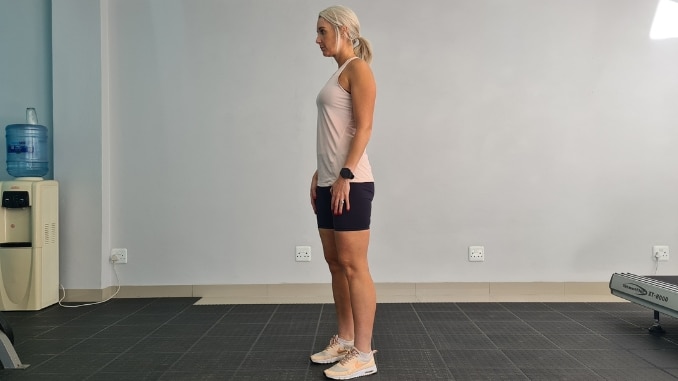 |
 |
2. Shoulder Twist
Begin in an upright standing position with your feet hip-width apart, maintaining good alignment with your head, shoulders, hips, and legs. Place your hands on your shoulders. Engage your core, then twist your upper body to one side while keeping your hips locked in the forward position. Return to the starting position and repeat the movement on the opposite side. Complete 10 repetitions.
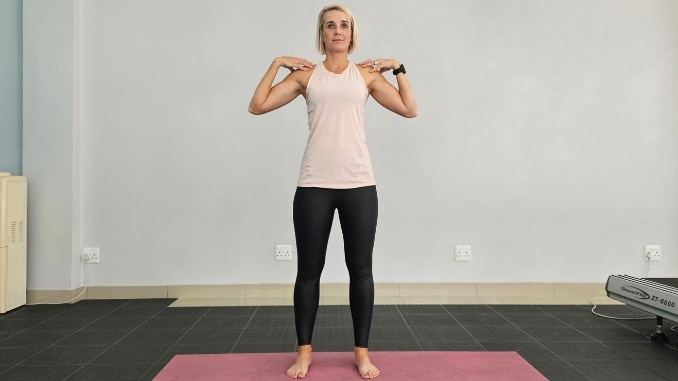 |
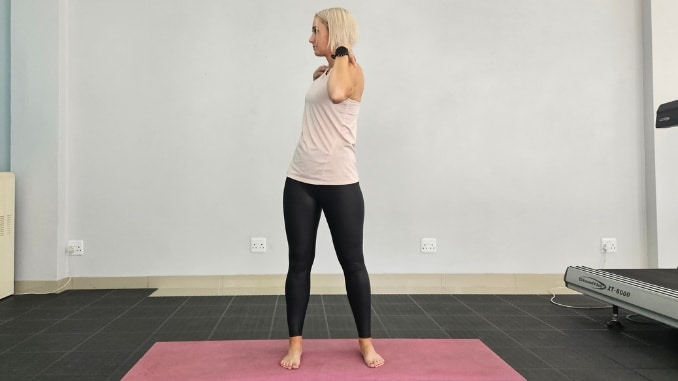 |
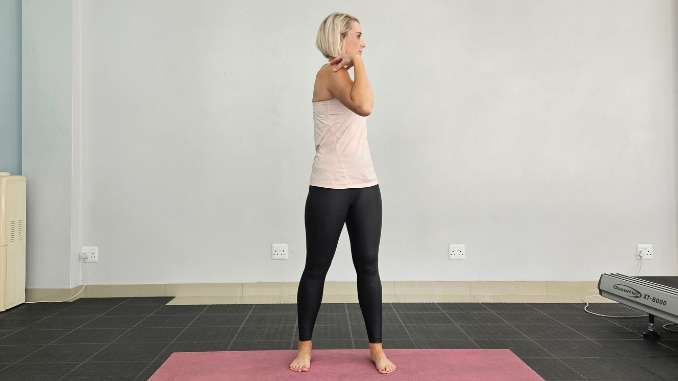 |
3. Squat
Begin in an upright standing position with your feet hip-width apart, maintaining good alignment with your head, shoulders, hips, and legs. Place your hands on your hips. Engage your core, bend your knees, and hinge through your hips to move into a squat position. Raise back to an upright standing position, squeezing your glutes at the top. Repeat the movement and complete 10 repetitions.
 |
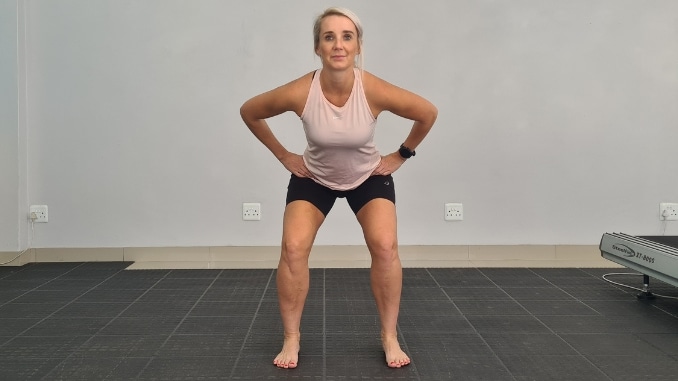 |
After the warm-up, stretching the muscles you target during your workout is essential. Hold each stretch for a couple of seconds and repeat on both sides. Focus on stretching your chest, shoulders, back, hips, hamstrings, and calves. Stretching helps improve flexibility, prevent injuries, and aid in muscle recovery.
No Equipment Full Body Workout Routines:
Now that you’re warmed up and stretched, it’s time to dive into our suggested bodyweight exercises. This routine is designed to be performed in a circuit format, dwelling from one exercise to the next with minimal rest in between. Aim to complete 3 sets of the circuit, resting for 60 seconds between each round. Adjust the number of repetitions and the intensity of the exercises based on your fitness level. Always be mindful to maintain proper form and pay attention to your body’s signals during your workout. Here are some fitting no-equipment workouts to try:
1. Leg Extension/Single-leg Deadlift
For this exercise, you can use a chair or countertop for balance.
Begin in an upright standing position with your feet shoulder-width apart, maintaining good alignment with your head, shoulders, hips, and legs. Place your hands on your hips. Engage your core and slightly bend your right leg as you transfer all your weight to your right foot. Hinge through your hips to bend forward until your upper body is parallel to the floor while extending your left leg back, reaching your hands to the floor. Raise back up to return to the starting position and repeat the movement. After several repetitions, perform the movement on the opposite side. Complete 3 sets of 10 repetitions on each side.
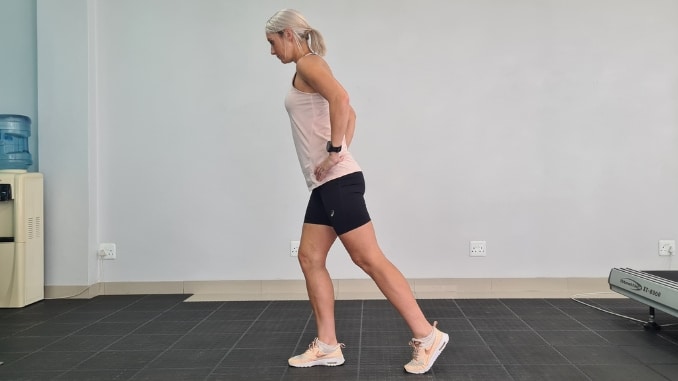 |
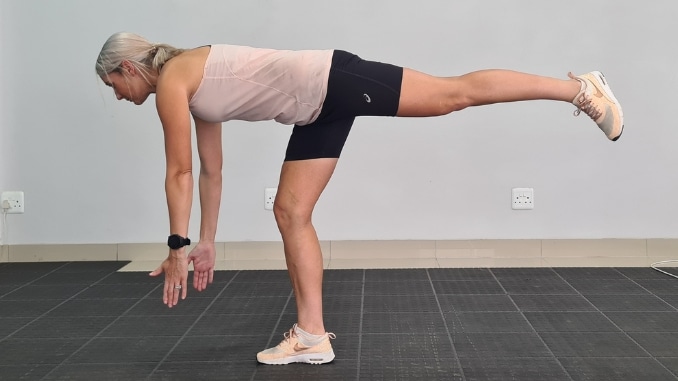 |
Note: If you can do it without holding onto the chair, feel free to take that challenge.
2. Wall Push-Up
For this exercise, you can use a wall or a post for balance if needed.
Begin in an upright standing position in front of the wall with your feet hip-width apart, maintaining good alignment with your head, shoulder, hips, and legs. Place both hands against the wall at shoulder height and step back with both feet to increase the angle of your body. Engage your core and bend your elbows to lower your upper body towards the wall, keeping your elbows tight to the side. Straighten your arms to return to the starting position and repeat the movement. Complete 3 sets, 10 repetitions.
 |
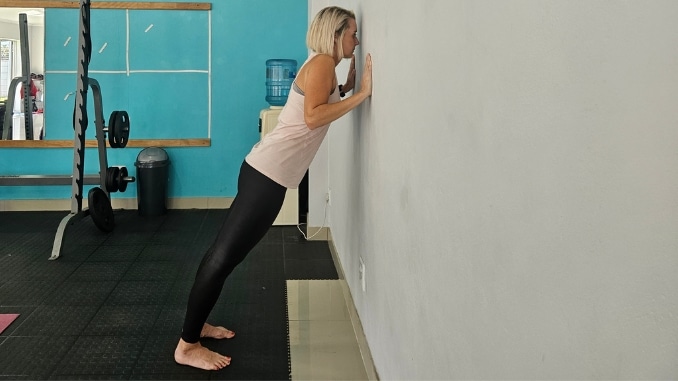 |
Note: To increase the difficulty of the exercise, reduce the angle of your body by leaning on a stable surface such as a countertop, table, or any short-height support.
Alternative Exercise
For this exercise, you can use a chair or a table.
Start in an upright standing position in front of a bench or chair. Place your palms flat on the bench and step back to move into a straight arm plank position, maintaining good alignment with your head, shoulders, hips, and toes. Engage your core and bend both your right elbow and left elbow to lower your upper body towards the bench, keeping your elbows tight to the side. Straighten your arms to return to the and complete the push-up movement. Complete 3 sets, 10 repetitions
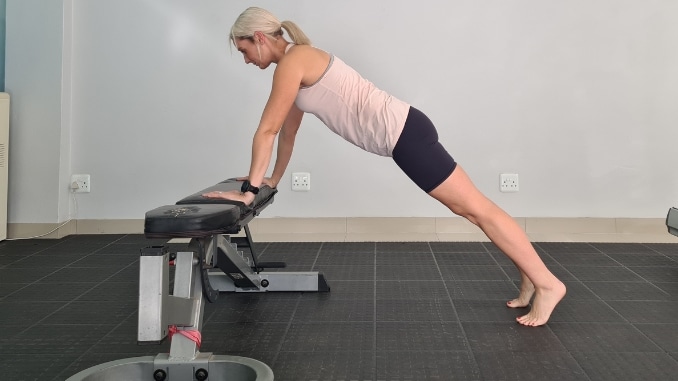 |
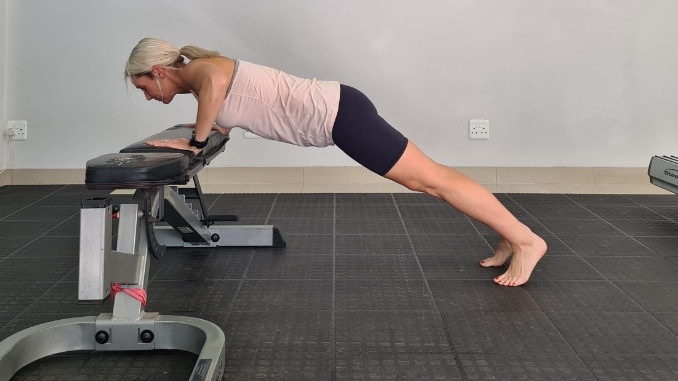 |
3. Lateral Leg Lifts
For this exercise, you can use a wall, post, or the back of your chair for balance and support if needed.
Begin in an upright standing position with your feet hip-width apart, maintaining good alignment with your head, shoulders, hips, and legs. Place one hand on your hip as you hold on to the back of the chair with your opposite hand. Engage your core and lift one leg out to the side, ideally to a 30 to 45-degree angle. Keep your toes pointing forward. Slowly lower your leg to the starting position and repeat the movement. After several repetitions, perform the movement on the opposite side. Complete 3 sets of 10 repetitions on each side.
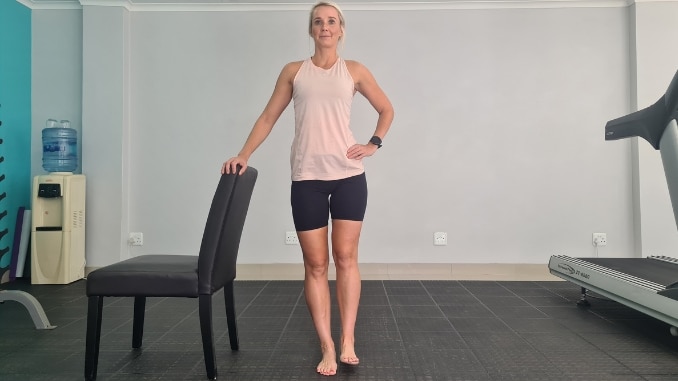 |
 |
4. Reach and Pull
Begin in an upright standing position with your feet shoulder-width apart, maintaining good alignment with your head, shoulders, hips, and legs. Engage your core. Extend both arms in front of your body at shoulder height. Pull your arms back, keeping your elbows in line with your shoulders and squeezing your shoulder blades together at the end position. Return to the starting position and repeat the movement.
 |
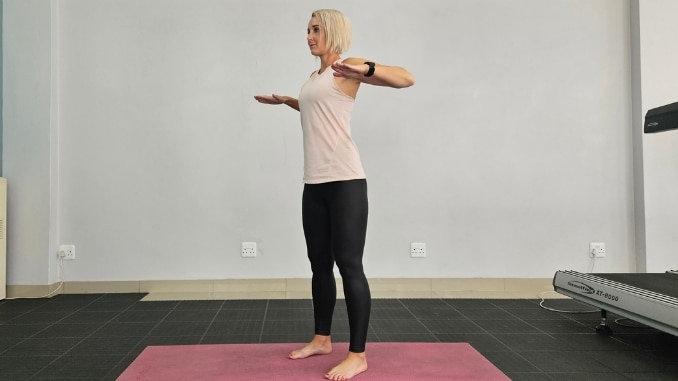 |
5. Squats with Chair/Sit to Stands
Begin in an upright standing position with your feet hip-width apart, maintaining good alignment with your head, shoulders, hips, and legs. Press your palms together in a prayer position at chest height. Engage your core, bend your knees, and hinge through your hips to move into a squat position to sit on the chair. Raise back up to an upright standing position, squeezing your glutes at the top. Complete with 3 sets of 10 repetitions.
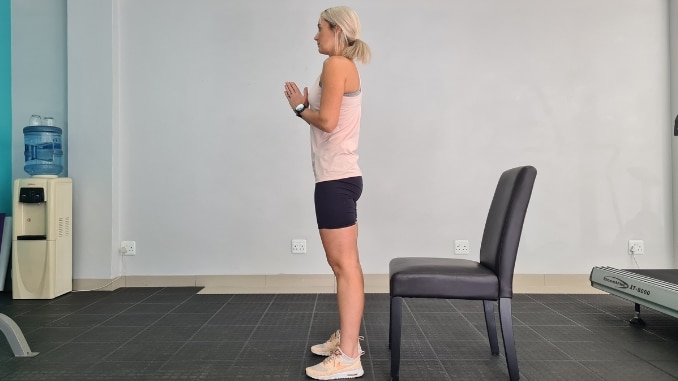 |
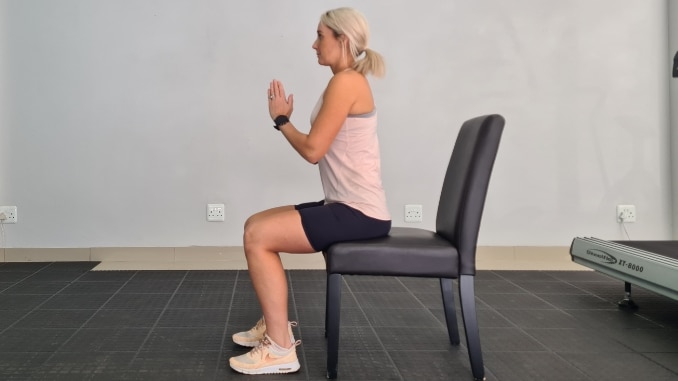 |
Note: If you can do it without the chair, feel free to take that challenge.
6. Knee to Shoulder
Begin in an upright sitting position on a chair with your feet hip-width apart, maintaining good alignment with your head, shoulders, and hips. Place your right hand on your shoulder and engage your core. Lift your left knee up towards your chest as you counter the movement by lowering your bent elbow. Return to the starting position and repeat the movement. After several repetitions, perform the movement with your right knee. Begin with 3 sets of 10 repetitions on each side.
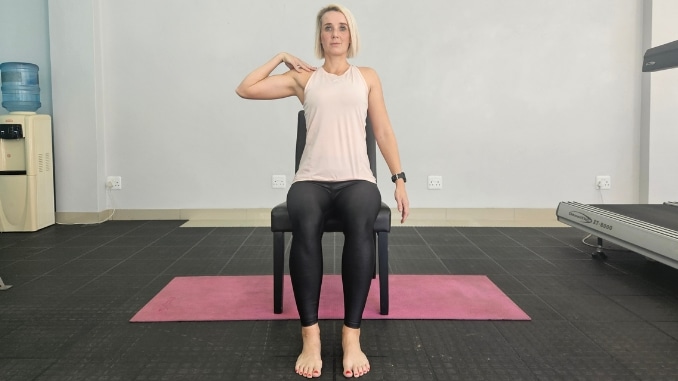 |
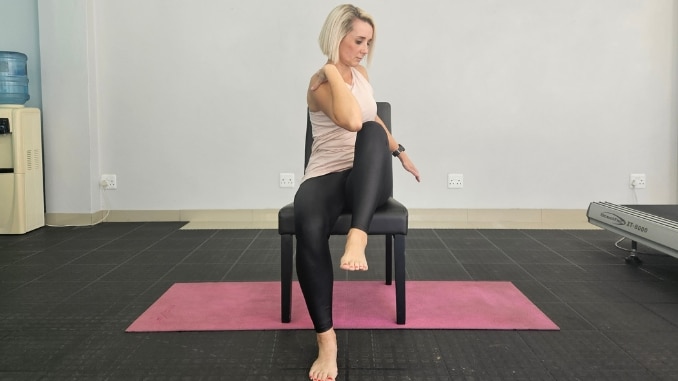 |
Tips for Maximizing your No Equipment Full Body Workout
To make the most of your no equipment full body workout, here are some tips to keep in mind:
- Focus on form: Proper form prevents injuries and effectively targets the intended muscles. Practice and learn the correct technique for each exercise before increasing the intensity or repetitions.
- Incorporate variations: As you become more proficient in the exercises, incorporate variations to keep your workouts challenging and engaging. For example, you can try one-legged squats, decline push-ups, or side plank variations.
- Add cardio intervals: Add short bursts of cardio exercises between strength exercises to increase the intensity and burn more calories. This can include jumping jacks, high knees, or skipping rope.
- Stay consistent: Consistency is one of the secrets to seeing results. Aim to incorporate a no equipment full body workout into your routine at least 2-3 times a week. Set aside dedicated time for your activities and make it a priority.
- Listen to your body: Pay attention to how your body feels during and after the workout. If something feels uncomfortable or painful, modify the exercise or seek guidance from a fitness professional. It’s important to listen to your body and avoid pushing through pain.
- Progress gradually: As you get more robust and more comfortable with the bodyweight exercises, slowly increase the intensity and repetitions or add more challenging variations. This will ensure continued progress and prevent plateauing.
No Equipment Full Body Workout Plan
To help you stay on track and make progress, here’s a sample weekly workout plan:
- Monday: No equipment full body workout (Circuit 1)
- Tuesday: Rest or low-intensity cardio (e.g., brisk walking, cycling)
- Wednesday: No equipment full body workout (Circuit 2)
- Thursday: Rest or flexibility training (e.g., yoga, stretching)
- Friday: No equipment full body workout (Circuit 1)
- Saturday: Rest or active recovery (e.g., light jog, swimming)
- Sunday: Rest or restorative activities (e.g., meditation, foam rolling)
Tracking Progress and Setting Goals
Tracking your progress and setting goals is essential to stay motivated and monitor your fitness journey. Here are some ways to track your progress in a no equipment full body workout:
- Keep a workout journal: Write down your workouts, including the exercises, repetitions, and any modifications or progressions you make. This will help you track your progress and serve as a reference for future workouts.
- Take measurements: Measure critical areas of your body, such as your waist, hips, thighs, and arms. Take these measurements at regular intervals to track changes in your body composition.
- Use a fitness app: Various fitness apps can track your workouts, set goals, and monitor your progress. These apps often provide workout plans, exercise demonstrations, and tracking features to keep you on track.
- Set SMART goals: Set specific, measurable, attainable, relevant, and time-bound (SMART) goals for your no equipment full body workouts. For example, you could aim to increase the number of push-ups you can do in one minute or improve your plank hold time by 10 seconds within a month.
By monitoring your progress and setting goals, you can stay motivated, acknowledge your accomplishments, and keep working to enhance your no-equipment full-body workouts.
Conclusion: Embracing The Convenience And Effectiveness Of No Equipment Full Body Workouts
In conclusion, no equipment full body workouts offer a practical and convenient way to stay fit and achieve your fitness goals without expensive equipment or gym memberships. You can shape and strengthen your entire body wherever you choose by utilizing your body weight and performing various workouts that target all major muscle groups. Whether you’re a newbie or a seasoned fitness enthusiast, integrating a no-equipment full-body workout into your regimen can aid you in attaining fitness excellence. Embrace the simplicity and adaptability of these equipment-free workouts to commence your path toward a healthier and more potent version of yourself. Remember, the most essential equipment you require is your determination and dedication to your fitness journey.
Bodyweight workouts are ideal for those who exercise at home, as they require no equipment and very little space. Check out our Bodyweight Workouts 101 now!


